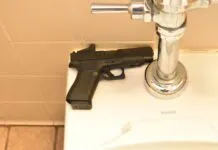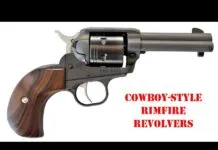The carbine offers greater accuracy and power than a handgun but is less clumsy to put into action than a ri?e. This makes the carbine especially handy when operating inside a building where walls and doorways limit movement and acquisition. Today’s most popular carbines are built on the AR-15 platform, which normally shoots 5.56mm or .223 Remington ammo-ri?e cartridges. But we recently evaluated three AR-15-style carbines with 16-inch barrels chambered for 9mm ammunition–normally handgun fodder. They were the $1050 Bushmaster Carbon 15, the $1035 Rock River Arms CAR A4, and from Olympic Arms the $834 model K9.
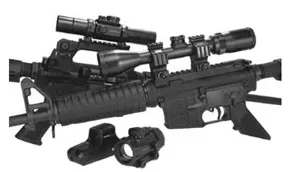
Why 9mm? The manufacturers said the round’s low cost and diminished penetration into walls were the main reasons. Two out of three reps said that civilian sales of 9mm carbines were higher than the total number sold to law enforcement, but the value of the 9mm carbine for training indoors is widely recognized. They also noted that the 9mm (0.355-inch diameter) bullet produced a larger wound canal in many instances than .223 Remington, the most common AR-15 round.
We decided to bench-test our carbines for accuracy at 50 yards using a Caldwell Tack Driver sandbag rest. Adding a scope of nearly any design would likely have improved our scores, but we shot all three weapons with open sights. For protection from the Texas sun, we set up beneath the covered benches of American Shooting Centers in Houston¡’s George Bush Park (amshootcenters.com). We also decided to try shooting each carbine from a three-point prone position. Lying atop a Dillon Shooting Mat, ($65 from Dillon Precision, 800-762-3845), the long magazines played a part in support, along with the elbows. We wanted to know if pressing down on the long, thin 9mm magazines would affect reliability. Given that virtually all the 9mm ammunition we found was intended for use in a handgun, we went so far as to seek advice in choice of test ammunition from Rock River Arms, Olympic Arms and Bushmaster. All three recommended the 115-grain FMJ round. Federal¡’s American Eagle 115-grain FMJ ammunition was the only name speci?cally mentioned, so we started with this round. We also tested with 115-grain FMJ Match rounds from Atlanta Arms and Ammo (atlantaarmsandammo.com). Next we tried a 75-grain frangible training round from Precision Ammunition (precisionammo.com). Precision¡’s CM9 Matrix NTF featured a copper non-toxic bullet that was designed to disintegrate rather than penetrate or ricochet off of hard surfaces, making training at close range with steel targets and walls much safer. But with so many different types of 9mm ammunition to choose from, we decided to try three different types of expanding ammunition as well. We tested with Federal¡’s 105-grain expanding FMJ rounds, Black Hills 115-grain JHP remanufactured loads and Speer¡’s 124 grain GDHP “Gold Dot” hollowpoints. The Gold Dots are among the most popular choice of professionals, so we wanted to see if it was viable to carry the same ammunition for pistol and carbine.
Here’s what we found:
Olympic Arms K9 9mm, $834
The Olympic Arms lineup of pistol-caliber carbines is built along the lines of an A2-style weapon, including a fully-adjustable rear sight seated in the carry handle. Other available calibers include .40 S&W, .45 ACP, and 10mm. The 9mm K9 was at least $200 less expensive than our other two carbines. All three carbines offered an adjustable-length stock that operated in the same manner, offering six different positions with about three-quarters of an inch between stops. Moving the stock was achieved by pressing upward on the spring-loaded catch and sliding the stock in and out along the buffer tube. This also set the distance between the trigger and the rear of the plastic buttstock, (LOP, or length of pull). Assault personnel often carry multiple weapons systems (pistol, carbine, etc.) with the carbine connected by a sling. Compacting the stock helps get the carbine out of the way when not in use. Another aspect of the adjustable stock is that with open sights, clarity of the front sight radius could be adjusted. We found that the front sight on the Olympic Arms K9 was thicker than the ones found on our other carbines, and we needed the maximum distance for our old eyes to obtain the clearest de?nition of the front sight.
Without the magazine in place the Olympic Arms K9 gave no outward clue that it was chambered for a pistol caliber. Typical AR-15 features included a plastic pistol grip, hinged trigger guard ?oor plate to accommodate wearing gloves or mittens, a spring loaded hinged ejection port cover, a shorter carbine length, polymer fore end, front sight adjustable for elevation and a bayonet lug. The A2 flash hider on the K9 differed from the A1 “bird cage” design found on our other two carbines by being longer and not offering a flat surface for gripping a wrench. Our K9 was the only gun in the test that offered a forward assist plunger for the bolt mounted in its traditional position along the right side of the receiver. One Sten magazine was supplied with the capacity of 32 rounds. Extra magazines cost $65. The magazine was welded up with a spacer along its rear surface to create a tight ?t inside the magazine well which otherwise appeared to be ready to accept a standard .223 Remington AR-15 magazine. Loading the magazine required depressing the follower and sliding each round into place just like a pistol magazine. Despite the K9 magazine holding the most rounds we preferred the magazines that came with the Rock River and Bushmaster carbines because they were much easier to load. They only required that we push straight downward on the follower and snap each round into place.
At the range we discovered one additional bene?t to ?ring a 9mm carbine. Heat, or rather the lack of it. Even after ?ring a hundred rounds or more, the 1-in-16-inch-twist barrel was just getting warm. The barrel of an AR chambered for .223 Remington would be blazing hot.
In terms of accuracy and performance, the Olympic Arms K9 met the standard set by its competitors. The American Eagle 115-grain FMJ rounds shot groups that averaged 1.5 inches at 50 yards (varying in group size between 1.2 and 1.8 inches). The Atlanta Arms and Ammunition 115-grain FMJ Match rounds rang up an average of 1.6 inches in our hands, which was certainly within shooter error of the 1.5-inch standard. The K9 also functioned well with the Precision Ammunition frangible training ammunition, landing 2.2-inch groups on average. Firing the expandable-tip ammunition, we found that the Federal 105-grain expanding FMJ round was our only alternative. The Olympic Arms K9 consistently failed to feed the last round of the Speer Gold Dots and hung up on the Black Hills 115-grain JHP rounds. This included setting back the JHP bullet into its case. We should also mention that when the magazine was empty, the bolt did not lock back. But the K9 did ?re reliably from the prone position all four of the rounds that it functioned with from the bench.
We liked the trigger on this carbine because it had the smoothest pull characterized by a continuous sweep. Only those who insist on a take-up followed by a crisp break might be dissatis?ed.
We would have preferred a thinner front sight with a square pro?le from top to bottom rather than the K9¡’s slightly spired shape, but the sight was easy to see, and with the variety of 9mm ammunition currently available, we think there may be greater accuracy available still from the Olympic Arms K9.
Bushmaster Carbon 15
9mm Carbine
No. AZ9-C15R16FT, $1050
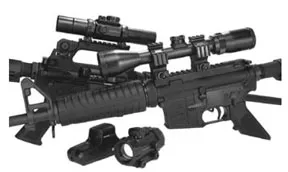
The only 9mm carbine in the Bushmaster lineup utilizes a carbon-?ber receiver. This made our Bushmaster Carbon 15 the lightest weapon in our match up by about 10 to 12 ounces, depending on the gun.
We noticed right away that there was no forward assist for the bolt, and the bottom of the trigger guard was not hinged but molded as a solid part of the receiver. The barrel was listed as carrying a 1:10 twist. The rear sight assembly was held to the Picatinny rail atop the receiver by two Allen screws. The rear sight was adjustable for windage only and offered two apertures. One was very large, measuring almost 0.2 inches and the other a little bigger than the tip of a ball point pen. In comparison the larger aperture found on the Olympic K9 measured about 0.175 inches across. We used the smaller aperture for testing each of our carbines. The front sight was square in silhouette and adjustable by traditional means, such as using the tip of a .223 Remington bullet to depress the detent and turn the sight clockwise for up and counterclockwise for down. The one supplied magazine was made from black polymer (extra magazines are $29). The receiver of the Carbon 15 was molded so that it will only ?t pistol-caliber magazines. Otherwise typical AR-15 features such as left-side safety, left-side bolt latch, and right side magazine release were in place.
Shooting the Carbon 15, we found it to be noisier in terms of mechanical operation than either the Olympic or Rock River products. Of our three guns, the Bushmaster was the only one that locked back every time the magazine was empty. But we had dif?culty releasing the magazine because of a stiff release button. We learned to push up on the magazine to free it. After about 300 rounds we no longer had to push upward on the magazine to release it, but the button remained stiff. Despite this problem, we liked how easily the magazines accepted fresh rounds, and shooting prone, the Carbon 15 proved to be 100-percent reliable.
The view provided by the supplied sights was very easy to work with. Firing our test rounds without expanding-tip bullets, we found that the Atlanta Arms and Ammo 115-grain FMJs were the best choice. They shot an average ?ve-shot group measuring about 1.4 inches across. The Federal American Eagle and the Precision frangible ammunition averaged closer to 2.0 inches across at 50 yards. The trigger featured a short take-up without any grit and a hard break after about 8.0 pounds of pressure was applied.
Firing the expanding ammunition, we found that the Black Hills 115-grain JHP rounds were the only reliable choice, averaging about 1.8 inches per ?ve-shot group. But we think this is good news for the shooter because there are many similar choices of 115-grain hollowpoints currently available.
In our view the lighter weight of the Carbon 15 contributed little to an increase in recoil ¡ just enough to be noticeable compared to our other carbines. Those seeking a lighter-weight carbine will be happy with this tradeoff, we feel.
Rock River Arms CAR A4 15
9mm Carbine
No. 9MM1222X, $1035
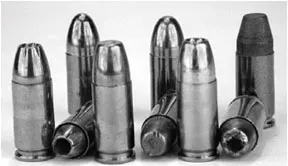
Rock River Arms offers two 9mm carbines, an A2 model and the one tested here, the CAR A4. The Rock River Arms carbine made a very good impression from the start.
Opening the cardboard shipping box, our evaluators found a blue injection-molded breakdown case. The case was lockable, but the latches were perhaps a little too flimsy to make it completely airline compliant. Nonetheless, this was an exceptional travel case.
The company website lists only one supplied magazine with extras sold at a price of $35 each. The magazines were modified 9mm Uzi magazines that are listed as holding 25 rounds, but we found ours would hold 26 rounds without malfunction. The magazine well of the CAR A4 was fit with an insert to accommodate the smaller steel-bodied Uzi magazines.
The front sight was a standard elevation adjustable unit. Its square, concise pro?le gave us a clean sight picture. The CAR A4 may appear to be less expensive than the Bushmaster Carbon 15, which it resembles in pro?le, but that is not the case. The buyer must pay extra for the rear-sight assembly or mount an optical device on the Picattiny rail. Rock River Arms lists a fully adjustable standalone rear sight unit for $110 (No. AR3305ASY). We failed to order this part, and ended up using a very similar product out of our stock for this test. The point is that the buyer is free to choose any sighting unit he wishes, but in comparing the prices of our test guns, the extra cost must be taken into account.
Regarding the mounting of a scope on our flattop models, both the Bushmaster and Rock River Arms carbines might have been better off being ?tted with either a ?ip-up front sight or, if it is one¡’s intention to use optics exclusively, not offer a front sight at all. We found that some dot scopes we tried were blocked by the front sight unless they were mounted on a riser. Tubular scopes required high mount rings.
The receiver appeared to be heavily built and offered an oversize case de?ector. The case de?ector was fashioned from a polymer or a carbon?ber material, and it covered a portion of the ejection port. The ejection port cover was shortened to accommodate the de?ector. There was no forward assist for the bolt, but the lower part of the trigger guard was hinged. The barrel was listed as being a chromemoly part by Wilson with a 1:10 twist. The Picatinny rail atop the receiver was marked every other notch to make it easy to repeat the desired location of a mounted accessory such as a scope.
Opening the CAR A4 to lubricate the bolt was very dif?cult at ?rst. This carbine was very tightly machined, but it became easier to disassemble after just the ?rst couple of times we opened it. None of the carbines in this test required much lubrication or maintenance during our tests. The amount of scuff found on the bolts was minor. A little Break Free to the recommended points was all that was needed.
At the bench we noticed that the trigger of the Rock River Arms CAR A4 required a slightly longer take-up than that of the Bushmaster carbine. Ultimately, the break required about 10 pounds of pressure. We weren’t concerned that this trigger was the heaviest among our three carbines, but the ?nal press included a disturbing level of creep that our shooters found distracting. When we determined that the Atlanta Arms and Ammo rounds were the only ones to print an average group of less than two inches across we found it easy to blame the trigger. But loading the CAR A4 with our expandable rounds changed our mind. Aside from suffering failures to feed and setting back the bullets of the Black Hills 115-grain JHP rounds, loading our other defense ammunition into the breach of the Rock River product was just short of a revelation. Firing the Federal 105-grain expanding metal-jacket ammunition, we began to print sub-1-inch groups. The Speer Gold Dots, unworkable in our other guns, brought the CAR A4 alive with similar results.
The Rock River Arms website listed accuracy for its 9mm carbine as 1.5-inch groups at 50 yards.
Gun Tests Recommends
* * * * *Olympic Arms K9
9mm, $834. Best Buy.
The K9 gets the job done as long as you stick with FMJ or expanding FMJ ammunition. Extra magazines were pricey, however.
*** Bushmaster Carbon 15
9mm Carbine
No. AZ9-C15R16FT, $1050. Buy It.
Lighter weight adds to portability, with some penalty in recoil. We liked that it would run reliably on 115-grain JHP ammunition. The removable rear sight was a plus.
¡ Rock River Arms CAR A4 15
9mm Carbine
No. 9MM1222X, $1035. Conditional Buy.
Reliability and accuracy were tops with defense rounds, but surprisingly lacking with common FMJ rounds. The trigger needed re?nement, and the rear sight cost extra. GT
Written and photographed by Roger Eckstine, using evaluations from GUN TESTS team testers.



